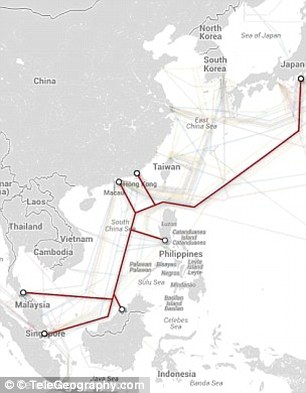Google is investing further in the underground cable
network by backing a project that will span the Pacific Ocean.
Called Faster, the $300 million (£178 million) scheme
will connect Japan to the west coast of the US.
The cable will stretch 5,000 miles (8,000km) under the
ocean, and will then link up with local cable systems already in place.
Faster
is expected to be completed by Spring 2016.
On the Japan side, the cable will land at Chikura and
Shima and is designed to improve the network further into Asia.
While on the US side, the cable will connect networks
in Los Angeles, San Francisco, Portland, and Seattle.
‘At Google we want our products to be fast and
reliable, and that requires a great network infrastructure, whether it's for
the more than a billion Android users or developers building products on Google
Cloud Platform,’ said Urs Hölze, senior vice president of technical
infrastructure at Google.
‘And
sometimes the fastest path requires going through an ocean.
'That’s why we’re investing in Faster, a new undersea
cable that will connect major West Coast cities in the US to two coastal
locations in Japan with a design capacity of 60 terabits per second.’
That’s ten million times faster than a household cable
modem.
Google has previously invested in other cable
projects, including Unity in 2008, which also joined Japan to the US, and the
South-East Asia Japan Cable (SJC) in 2011.
 |
| South-East Asia Japan Cable (SJC) in 2011 |
The
SJC links eight points in Asia including Chikura in Japan, Shantou in China,
Chung Hom Kok, Hong Kong, Nasugbu, the Philippines, Telisai, Brunei, Songkhla,
Thailand, and Tuas, Singapore.
In addition to Google, the Faster project has been
backed by China Mobile International, China Telecom Global, Global Transit,
KDDI, and SingTel.
Mr. Woohyong Choi, the chairman of the Faster
executive committee, said: 'Faster is one of a few hundred submarine
telecommunications cables connecting various parts of the world.
'These cables collectively form an important
infrastructure that helps run global Internet and communications.
‘The Faster cable system has the largest design
capacity ever built on the Trans-Pacific route, which is one of the longest
routes in the world.
‘The agreement announced today will benefit all users
of the global Internet.'
Almost 95 per cent of the internet used everyday is
carried between countries through two-inch (50mm) thick lines.
In 2006, submarine cables carried just one per cent of
traffic - an increase of 94 per cent in just eight years, according to official
figures from the International Cable Protection Committee.
Since
2012, the number of submarine cables have almost doubled from 150 to 285. Culled from Daily Mail



No comments:
Post a Comment